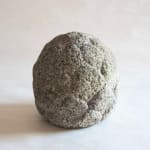




artisan's name unknown
The single-petal Hoju stone, Late Muromachi Period (16th century)
Stone
7" 1/4" x 7"
Further images
The carving of stones stems from a tradition long practiced in Japan. Stones are an essential facet of Japanese art and design, regarded alongside the highest forms of painting or...
The carving of stones stems from a tradition long practiced in Japan. Stones are an essential facet of Japanese art and design, regarded alongside the highest forms of painting or ceramic arts. Stones are old and silent, pregnant with a melancholy feeling, but that doesn't mean they don't speak. It takes time and a deep sensitivity to allow an understanding of stones to stir within us. They will remain flat and impenetrable to a mind prone to restlessness but reveal themselves to a calm mind.
This piece is a Hoju—the top of a stone Pagoda statue placed in a temple garden. It was carved in the late 16th century. Only the Hoju remained. As time went on, later pieces had double-petals. The single petal allows us to date the piece and provides a representation of the evolution of styles.
This piece is a Hoju—the top of a stone Pagoda statue placed in a temple garden. It was carved in the late 16th century. Only the Hoju remained. As time went on, later pieces had double-petals. The single petal allows us to date the piece and provides a representation of the evolution of styles.
Signup for our Newsletter
You will receive two emails a month from us. One introduces artworks and design works from Kyoto's hidden sources and the other is stories from Misako, sharing insights into Japanese culture.
* denotes required fields
为了回应您的查询,我们将根据我们的隐私政策处理您提供的个人数据。




